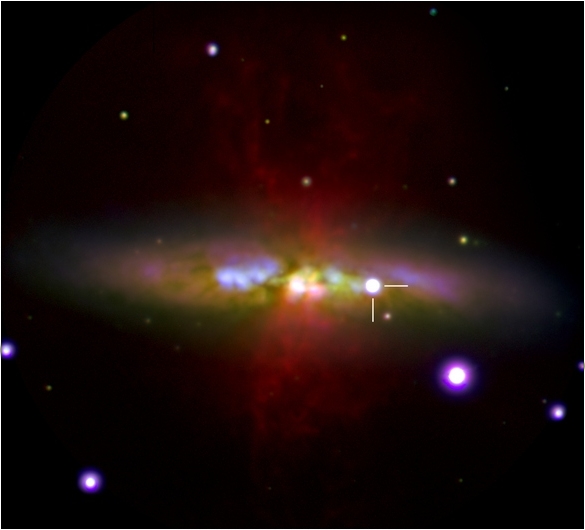A type Ia supernova, the closest to Earth since 1604, has been observed
SN 2014J, discovered in galaxy M82, has mobilized experts from around the world. Pictures of the supernova were taken at the Estallidos Project site, coordinated by IAA, using the William Herschel telescope
SN 2014J, discovered in galaxy M82, has mobilized experts from around the world. Pictures of the supernova were taken at the Estallidos Project site, coordinated by IAA, using the William Herschel telescope
On Tuesday, January 15th, British astrophysicist Steve Fossey was giving a practical astronomical observation class to a group of students, and when they pointed their telescope to M 82, a galaxy twelve million light years away from us, they were surprised to see a bright, so far unknown star; as it turned out, they had just discovered a supernova: an explosion produced by the death of a massive star.
Twenty four hours later, a group of US astrophysicists announced that the spectrum of the supernova, named SN 2014J, indicated that it had originated from a white dwarf, which typifies the supernova as a type Ia.
The scarcity of this type of supernovas (especially within short range) and their reliability for measuring astronomical distances makes this new discovery highly relevant. In fact, this kind of supernova observation was key to the discovery that the universe was expanding at an accelerating rate.
Here in Spain, at the Roque de los Muchachos Observatory in La Palma, astrophysicists Manuel Moreno-Raya (CIEMAT) and Lluís Galbany (DAS/UC, Chile) were able to observe the supernova and the galaxy in detail from Thursday, January 23rd , through Sunday, January 26th, using images as well as spectra yielded by the William Herschel Telescope(WHT).

The data was analyzed by astrophysicist Ángel López-Sánchez (AAO/MQ, Australia), who combined the images and the spectra and confirmed that it was indeed a type Ia supernova. Its most notable features are the iron (Fe II and Fe III), magnesium (Mg II) and silicon (Si II) absorption bands.
The spectral lines of these metals are fused together by the violent supernova explosion. It is expected that they will change as the concentration and abundance of each chemical element varies--one element changing into other elements—and that it will be possible to observe more material coming from the centre of the dead star.
The spectral line that has drawn most attention from researchers is a small carbon absorption line (C II) that indicates that the white dwarf at the origin of the supernova was composed of carbon and oxygen (like most white dwarfs) but it is unusual to observe those lines in the spectra of type Ia supernovas. This seems to indicate that the surface of the white dwarf did not entirely burn up during the explosion.
The objective of the project in which Moreno-Raya is taking part is precisely to calculate physical and chemical properties of galaxies which have hosted type Ia supernovas. The project is called ESTALLIDOS; it is coordinated by the Institute of Astrophysics of Andalusia and collaborates with CIEMAT, IAC and the Autonomous University of Madrid. The project studies galaxies with recent bouts of stellar formation that involve massive stars able to ionize the interstellar medium in detail.
SN2014J is the type Ia supernova closest to Earth since the one German astronomer Johannes Kepler observed in 1604. That one took place in our own galaxy at a distance of twenty thousand light years, and it was visible even with the naked eye.
Instituto de Astrofísica de Andalucía (IAA-CSIC)
Unidad de Divulgación y Comunicación
Silbia López de Lacalle - sll[arroba]iaa.es - 958230532
http://www.iaa.es
http://divulgacion.iaa.es

